The Influence of Groundwater Management on Land Subsidence Patterns in the Metropolitan Region of Guatemala City: A Multi-Temporal InSAR Analysis
Abstract
1. Introduction
1.1. Ground Deformation Dynamics in the MRG
1.2. Previous Hydrogeological Studies
1.3. MT-InSAR for Groundwater Monitoring
1.4. Aims and Scope
2. Materials and Methods
2.1. Study Area
- Upper alluvial aquifer: The study area is extensively overlain with volcanic ash, pyroclastic materials, and alluvial deposits, with the latter being nearer to the surface. According to JICA [13], these volcanic sediments have been shaped by river erosion, creating deep, branched gullies with depths varying from 150 to 250 m. Superficial aquifers are located within these sediment layers. The alluvium constitutes a notably shallow aquifer, generally under 50 m deep, with the extracted water primarily designated for non-potable uses. These aquifers are situated in valley beds and colluvial deposits formed from Quaternary erosion on the slopes. Given the significant reduction in flow during droughts and hydraulic connection to rivers, these aquifers are not regarded as viable for hydrogeological exploitation, owing to their depletion risk. Additionally, they lack both vertical and horizontal continuity [37].
- Upper Pyroclastic Aquifer: The aquifer, composed of pyroclasts and volcanic fillings, can extend to depths ranging from 200 to 400 m. Its transmissivity depends on the material’s porosity. There can be transmissivity between different basin pyroclastic aquifers, one in the northern basin and one in the southern basin. Therefore, rain falling in the northern aquifer could end up in the southern basin pyroclastic aquifer.
- Andesitic and basaltic lava formations, due to their nature, exhibit depositional structures, consolidation processes, and a notable tendency to develop open fractures. These features, along with their hardness, render them effective aquifer materials. This aspect is conducive to aquifer system development, with their efficiency reliant on connections to broad recharge zones that support the renewal and preservation of subterranean water resources [13].
- Lower Andesitic Lava Aquifer: Found at deeper levels, this aquifer is composed of hard, impermeable material derived from old volcanic flows. Its water storage is confined to areas that are fractured or have significant structural discontinuities, such as faults. Water recharge occurs not only from infiltration from the overlying strata but also from surface outcrops [13].
- Lower Limestone Aquifer: Comprising ancient, isolated limestone, this aquifer system operates distinctly due to its reliance on conduits rather than pore spaces [13]. The intrinsic porosity of the limestone varies, and its secondary permeability in carbonate aquifers results from the dissolution of bedding planes, fractures, and faults, rendering them highly anisotropic and heterogeneous [12].
2.2. Characterization of Each Hydrological Basin
- -
- Northern basin: corresponding to the Las Vacas River basin, which is fed by the Chinautla and El Zapote rivers. Geologically, this area is marked by the uplift of the Cretaceous carbonate basement. Here, Tertiary volcanic rocks to the south with thicknesses of 500 m and Quaternary pumice pyroclasts with thicknesses of 40 to 120 m can be observed. The limestones outcrop in the middle part of the basin and reach thicknesses of 600 m. Water circulation is limited, with values of 3 L/second, and the environment is highly fractured. In the northern basin of Guatemala City, two aquifers are identified: one of limestones in the central and northern parts, and another volcanic aquifer formed by tuffs and volcanic lavas, both exhibiting secondary permeability due to fracturing [12]. Moreover, while there used to be approximately 150 drilled wells [1], it is now estimated that there are around 1000 drilled wells, both municipal and privately owned [12].
- -
- Southern basin: As detailed by [38], the hydrogeological units in this area are illustrated in Figure 5. This area encompasses fractured volcanic formations, pumice pyroclastic deposits, and the alluvial materials of the Villalobos River. The volcanic components, made up of dacites, andesites, and Tertiary welded tuffs with thicknesses exceeding 500 m, form the saturated zone and a fissured environment or a rock formation with fractures. In contrast, the unsaturated zone primarily consists of Quaternary pumice Pyroclasts. In the southern section near the Villalobos River, the river’s fluvio-lacustrine sediments and alluvium are saturated and make up a phreatic upper aquifer. It is estimated that there are currently more than 500 wells in the basin, according to IARNA-URL and TNC [22].
- -
- Eastern basin: The hydrogeological structure of this basin is characterized by fractured volcanic rocks from the Tertiary period. These include vitric welded tuffs and basaltic andesitic lavas, which are over 500 m thick, creating a saturated zone that extends beyond a depth of 200 m. Additionally, the unsaturated zone is primarily made up of Quaternary pyroclastic deposits, with thicknesses of between 80 and 120 m observed in the northern and southern regions of the basin. Although 60 wells have been documented in this area, the estimated total number of wells was believed to be over 100 in 2016 [38].
2.3. MT-InSAR Processing and Analysis
2.4. Hydrogeological Characterization
2.4.1. Definition of Deformation Area of Influence per Well
2.4.2. Assigning a Lithologic Information Column to Each Well
2.5. Correlation Analysis
- Surface Geology according to Applied Lithologic Column: Geology associated with each well at the surface layer.
- Geology coinciding with the Mean Water Table Level of Measurements: Geology associated with each well that matches the average of the two piezometric measurements.
- Lithologic Column Models: Considering the types of aquifers in each column and their spatial arrangement, typical column models were established.
- Additionally, three more classifications were considered based on spatial analyses derived from other relevant products:
- Hydrological Basin: Using hydrological basin cartography. The basins described in the introduction were delimited based on the 12.5 m resolution Digital Terrestrial Model (DTM) [41].
3. Results
3.1. Relation of Ground Deformation and Hydrogeological Data
3.2. Analysis of the Lithological Columns of the Wells
3.3. Statistical Analysis of the Relationship Between Deformation and Piezometric Difference
- Alluvial aquifer: Figure 12a shows a strong correlation between deformation and piezometric dynamics with a Pearson coefficient of 0.988, despite being based on a small sample of only three measurement points within a 150 m buffer from the center of the wells. This strong relationship indicates a significant connection between piezometric difference and deformation rate in areas identified by Funcagua et al. [15]. As concentrations of regional groundwater flows. Furthermore, these points correspond to areas with the highest rates of deformation, reaching up to −60 mm/year according to García-Lanchares et al. [4], and are also the zones where the highest levels of water extraction are recorded [13].
- Pyroclasts aquifer: Figure 12b reveals a significant positive correlation, with a Pearson coefficient of 0.869, between the piezometric difference and the deformation rate for wells with a water table in pyroclastic geology. This reflects the fact that an increase in the piezometric difference, measured within a 50 m buffer from the center of the wells, is associated with an increase in the rate of ground deformation. These wells are distributed throughout the North and South basin areas.
- Andesitic aquifer: Analysis shows that there is no correlation between piezometric level and surface deformation for the wells with piezometric level in andesites for the whole study area, that is, the wells at the three basins. However, the correlation found specifically for the wells (with piezometric level in andesitic aquifer) of the East basin, for the selected buffer of 150 m, is 0.796, suggesting a direct relationship between the rate of deformation and piezometry between the two dates and a meaningful difference among the basins, which could be related to water extraction or structural differences. (Figure 12d).
- Limestone Aquifer: The scarce data from the limestone aquifer reveal no strong direct relationship between piezometric difference and deformation, which could be attributed to a lack of understanding of the internal structures resulting in a wide diversity of transmissivity. Given the limited sample size of only n = 5 wells, the data from the limestone aquifers show no correlation with the observed piezometric dynamics. The highly anisotropic and heterogeneous nature of carbonate aquifers, as reported by Herrera et al. [12], leads to differences in transmissivity measurements, ranging from 10 to 80 m2/day in poorly fractured rocks. This great variability in transmissivity reflects the difficulty in establishing solid statistics for these aquifers.
4. Discussion
4.1. Relationship Between Ground Deformation and Hydrogeological Data
4.2. Statistical Analysis of the Relationship Between Deformation and Piezometric Change
5. Conclusions
Author Contributions
Funding
Data Availability Statement
Acknowledgments
Conflicts of Interest
References
- Andretti, A. Informe Final del Estudio de Aguas Subterráneas en el valla de la Ciudad de Guatemala; Insivumeh-IGN-ONU, Ciudad de Guatemala, Proyecto Estudio de Aguas Subterráneas en Guatemala; Sección de Aguas Subterráneas, Instituto Nacional de Sismología, Vulcanología, Meteorología e Hidrología: Ciudad de Guatemala, Guatemala, 1978.
- Denyer, P. Geología Y Geotectónica de América Central y el Caribe. Available online: https://app.ingemmet.gob.pe/biblioteca/pdf/CPG14-010.pdf (accessed on 7 January 2024).
- Vega, A.; Domínguez, J.M. Hundimientos en Guatemala: Dónde Están Y Cómo Son Los Que Han Aparecido En Los Úlitmos Meses; Prensa Libre: Ciudad de Guatemala, Guatemala, 2022; pp. 1338–1343. [Google Scholar]
- García-Lanchares, C.; Marchamalo-Sacristán, M.; Fernández-Landa, A.; Sancho, C.; Krishnakumar, V.; Benito, B. Analysis of Deformation Dynamics in Guatemala City Metropolitan Area Using Persistent Scatterer Interferometry. Remote Sens. 2023, 15, 4207. [Google Scholar] [CrossRef]
- Kim, Y.C.; Kim, D.J.; Jung, J. Monitoring Land Subsidence in Guatemala City Using Time-Series Interferometry. In Proceedings of the IGARSS 2019-2019 IEEE International Geoscience and Remote Sensing Symposium, Yokohama, Japan, 28 July–2 August 2019; pp. 2099–2102. [Google Scholar] [CrossRef]
- Abidin, H.Z.; Andreas, H.; Gumilar, I.; Fukuda, Y.; Pohan, Y.E.; Deguchi, T. Land subsidence of Jakarta (Indonesia) and its relation with urban development. Nat. Hazards 2011, 59, 1753–1771. [Google Scholar] [CrossRef]
- Marfai, M.A.; King, L. Monitoring land subsidence in Semarang, Indonesia. Environ. Geol. 2007, 53, 651–659. [Google Scholar] [CrossRef]
- Cigna, F.; Tapete, D. Urban growth and land subsidence: Multi-decadal investigation using human settlement data and satellite InSAR in Morelia, Mexico. Sci. Total Environ. 2022, 811, 152211. [Google Scholar] [CrossRef]
- Figueroa-Miranda, S.; Tuxpan-Vargas, J.; Ramos-Leal, J.A.; Hernández-Madrigal, V.M.; Villaseñor-Reyes, C.I. Land subsidence by groundwater over-exploitation from aquifers in tectonic valleys of Central Mexico: A review. Eng. Geol. 2018, 246, 91–106. [Google Scholar] [CrossRef]
- Zhu, L.; Gong, H.; Li, X.; Wang, R.; Chen, B.; Dai, Z.; Teatini, P. Land subsidence due to groundwater withdrawal in the northern Beijing plain, China. Eng. Geol. 2015, 193, 243–255. [Google Scholar] [CrossRef]
- Herrera, I.R.; Orozco, E.O. Hidrogeología de Ojo de Agua, cuenca sur de la ciudad de Guatemala. Rev. Geol. Am. Cent. 2010, 42, 85–98. [Google Scholar] [CrossRef][Green Version]
- Herrera, I.R. Sobreextracción de las aguas subterráneas en la cuenca norte de la ciudad de Guatemala. Rev. Cient. Fac. Agron. Univ. San Carlos Guatem. Rev. 2018, XXXVI, 7–29. Available online: http://cete.fausac.gt/wp-content/uploads/2018/10/tikalia-2-2018.pdf (accessed on 4 October 2022).
- JICA (Agencia de Cooperación Internacional del Japón). Informe Final del estudio de Factibilidad Para el Desarrollo del Proyecto de Agua Subterránea (Para emergencia I); EMPAGUA (Empresa Municipal de agua de la Ciudad de Guatemala): Ciudad de Guatemala, Guatemala, 1986; Volume 8.
- Morales, J.I. Evaluación del Descenso del Nivel Freático en la Parte Norte del Acuífero Motropolitano en el Valle de GUATEMALA; San Carlos de Guatemala: Ciudad de Guatemala, Guatemala, 2012; Available online: https://revistas.usac.edu.gt/index.php/asa/article/view/1487 (accessed on 31 January 2023).
- FUNCAGUA. Análisis Piezométricos de Pozos de Agua Para los Municipios de la Mancomunidad Gran Ciudad del Sur:Amatitlán, Mixco, San Miguel Petapa, Santa Catarina Pinula, Villa canales y Villa Nueva, Guatemala; Fundación para la Conservación del Agua en la Región Metropolitana de Guatemala (FUCAGUA): Ciudad de Guatemala, Guatemala, 2019. [Google Scholar]
- Tzampoglou, P.; Ilia, I.; Karalis, K.; Tsangaratos, P.; Zhao, X.; Chen, W. Selected Worldwide Cases of Land Subsidence Due to Groundwater Withdrawal. Water 2023, 15, 1094. [Google Scholar] [CrossRef]
- Bahri, A. Integrated Urban Water Management; TEC BACKGROUND PAPERS: Stockholm, Sweden, 2012. [Google Scholar]
- Instituto Nacional de Estadística Guatemala. XII Censo Nacional de Población y VII de Vivienda; INE: Cary, NC, USA, 2019.
- UNISDR. Reducción del Riesgo de Desastres: Un Instrumento Para Alcanzar los Objetivos de Desarrollo del Milenio; Unión Interparlamentaria: Ginebra, Suiza, 2010. [Google Scholar]
- Gleeson, T.; Vander Steen, J.; Sophocleous, M.A.; Taniguchi, M.; Alley, W.M.; Allen, D.M.; Zhou, Y. Groundwater sustainability strategies. Nat. Geosci. 2010, 3, 378–379. [Google Scholar] [CrossRef]
- Wada, Y.; Van Beek, L.P.H.; Van Kempen, C.M.; Reckman, J.W.T.M.; Vasak, S.; Bierkens, M.F.P. Global depletion of groundwater resources. Geophys. Res. Lett. 2010, 37, 20. [Google Scholar] [CrossRef]
- IARNA and TNC. Bases Técnicas para la Gestión del agua con Visión de largo Plazo en la Zona Metropolitana de Guatemala; Instituto de Agricultura, Recursos Naturales y Ambiente de la Universidad Rafael Landívar: Ciudad de Guatemala, Guatemala, 2013; Available online: https://www.plazapublica.com.gt/sites/default/files/Bases_tecnicas_gestion_del_agua.pdf (accessed on 18 December 2023).
- Empagua, Mancomunidad Gran Ciudad del Sur, UICN, y AECID. Estrategia de Seguridad Hídrica para los Municipios de la Mancomunidad Gran Ciudad del Sur, Compatible con una Explotación Sostenible del Acuífero del Valle de la Ciudad de Guatemala; AECID: Ciudad de Guatemala, Guatemala, 2023.
- Massonnet, D.; Feigl, K.L. Radar interferometry and its application to changes in the Earth’s surface. Rev. Geophys. 1998, 36, 441–500. [Google Scholar] [CrossRef]
- Galloway, D.L.; Hoffmann, J. The application of satellite differential SAR interferometry-derived ground displacements in hydrogeology. Hydrogeol. J. 2007, 15, 133–154. [Google Scholar] [CrossRef]
- Bru, G.; Herrera, G.; Tomás, R.; Duro, J.; De La Vega, R.; Mulas, J. Control of deformation of buildings affected by subsidence using persistent scatterer interferometry. Struct. Infrastruct. Eng. 2013, 9, 188–200. [Google Scholar] [CrossRef]
- Castellazzi, P.; Arroyo-Domínguez, N.; Martel, R.; Calderhead, A.I.; Normand, J.C.L.; Gárfias, J.; Rivera, A. Land subsidence in major cities of Central Mexico: Interpreting InSAR-derived land subsidence mapping with hydrogeological data. Int. J. Appl. Earth Obs. Geoinf. 2016, 47, 102–111. [Google Scholar] [CrossRef]
- Ezquerro, P.; Herrera, G.; Marchamalo, M.; Tomás, R.; Béjar-Pizarro, M.; Martínez, R. A quasi-elastic aquifer deformational behavior: Madrid aquifer case study. J. Hydrol. 2014, 519, 1192–1204. [Google Scholar] [CrossRef]
- Radutu, A.; Nedelcu, I.; Gogu, C.R. An overview of ground surface displacements generated by groundwater dynamics, revealed by InSAR techniques. Procedia Eng. 2017, 209, 119–126. [Google Scholar] [CrossRef]
- Chen, F.; Lin, H.; Zhang, Y.; Lu, Z. Ground subsidence geo-hazards induced by rapid urbanization: Implications from InSAR observation and geological analysis. Nat. Hazards Earth Syst. Sci. 2012, 12, 935–942. [Google Scholar] [CrossRef]
- Navarro-Hernández, M.I.; Tomás, R.; Valdes-Abellan, J.; Bru, G.; Ezquerro, P.; Guardiola-Albert, C.; Elçi, A.; Batkan, E.A.; Caylak, B.; Ören, A.H.; et al. Monitoring land subsidence induced by tectonic activity and groundwater extraction in the eastern Gediz River Basin (Türkiye) using Sentinel-1 observations. Eng. Geol. 2023, 327, 107343. [Google Scholar] [CrossRef]
- Velásquez, E. Estudio Hidrogeológico de los Acuíferos Aluviales del río Villalobos; EMPAGUA: Ciudad de Guatemala, Guatemala, 2018. [Google Scholar]
- Famiglietti, J.S. The global groundwater crisis. Nat. Clim. Chang. 2014, 4, 945–948. [Google Scholar] [CrossRef]
- Chaussard, E.; Milillo, P.; Bürgmann, R.; Perissin, D.; Fielding, E.J.; Baker, B. Remote Sensing of Ground Deformation for Monitoring Groundwater Management Practices: Application to the Santa Clara Valley During the 2012–2015 California Drought. J. Geophys. Res. Solid Earth 2017, 122, 8566–8582. [Google Scholar] [CrossRef]
- Cigna, F.; Ramírez, R.E.; Tapete, D. Accuracy of Sentinel-1 PSI and SBAS InSAR Displacement Velocities against GNSS and Geodetic Leveling Monitoring Data. Remote Sens. 2021, 13, 4800. [Google Scholar] [CrossRef]
- Ezquerro Martín, P. Estudio de la Subsidencia del Terreno Producida Por la Explotación de Acuíferos Mediante Datos de Interferometría Radar Satélite. Ph.D. Thesis, Universidad Politécnica de Madrid, Madrid, Spain, 2021. [Google Scholar] [CrossRef]
- Galicia Guillén, O.R. Estudio Hidrogeológico Preliminar de las Calizas Zona Norte, Ciudad Guatemala; Centro Universitario del Norte, Universidad de San Carlos de Guatemala: Alta Verapaz, Guatemala, 1997. [Google Scholar]
- Herrera, I.R.; Barrientos, D.; Hernández, E. Estudio Hidrogeológico de los Acuíferos Volcánicos de la República de Guatemala; Universidad de San Carlos de Guatemala: Alta Verapaz, Guatemala, 2016; p. 121. [Google Scholar]
- Foumelis, M.; Blasco, J.M.D.; Desnos, Y.L.; Engdahl, M.; Fernandez, D.; Veci, L.; Lu, J.; Wong, C. Esa Snap-Stamps Integrated Processing for Sentinel-1 Persistent Scatterer Interferometry. In Proceedings of the IGARSS 2018-2018 IEEE International Geoscience and Remote Sensing Symposium, Valencia, Spain, 22–27 July 2018; pp. 1364–1367. [Google Scholar]
- Balbi, E.; Terrone, M.; Faccini, F.; Scafidi, D.; Barani, S.; Tosi, S.; Crispini, L.; Cianfarra, P.; Poggi, F.; Ferretti, G. Persistent Scatterer Interferometry and Statistical Analysis of Time-Series for Landslide Monitoring: Application to Santo Stefano d’Aveto (Liguria, NW Italy). Remote Sens. 2021, 13, 3348. [Google Scholar] [CrossRef]
- Japanase Aerospace Exploration Agency. JAXA7 METI ALOS PALSAR L1.0. JAXA, 19 de julio de 2023. Available online: https://global.jaxa.jp/ (accessed on 19 July 2015).
- Miller, B.; Schaetzl, R. History of soil geography in the context of scale. Geoderma 2016, 264, 284–300. [Google Scholar] [CrossRef]
- FAO. Guía para la Descripción de Suelos Capítulo 3: Descripción de los Factores Formadores del Suelo-Guías para la Descripción del Suelo; SOTER: Roma, Italy, 2009; Available online: https://www.fao.org/3/a0541s/a0541s.pdf (accessed on 21 December 2023).
- Pearson, K. Mathematical Contribution to the Theory of Evolution.-III Regression, Heredity, and Panmixia; Royal Society: London, UK, 1896. [Google Scholar]
- Pesaresi, P.; Politis, P. GHS-BUILT-C R2022A—GHS Settlement Characteristics; European Commission, Joint Research Centre (JRC): Brussels, Belgium, 2022. [Google Scholar]
- Brunori, C.A.; Bignami, C.; Albano, M.; Zucca, F.; Samsonov, S.; Groppelli, G.; Norini, G.; Saroli, M.; Stramondo, S. Land subsidence, Ground Fissures and Buried Faults: InSAR Monitoring of Ciudad Guzmán. Remote Sens. 2015, 7, 8610–8630. [Google Scholar] [CrossRef]
- Coda, S.; Confuorto, P.; De Vita, P.; Di Martire, D.; Allocca, V. Uplift Evidences Related to the Recession of Groundwater Abstraction in a Pyroclastic-Alluvial Aquifer of Southern Italy. Geosciences 2019, 9, 215. [Google Scholar] [CrossRef]

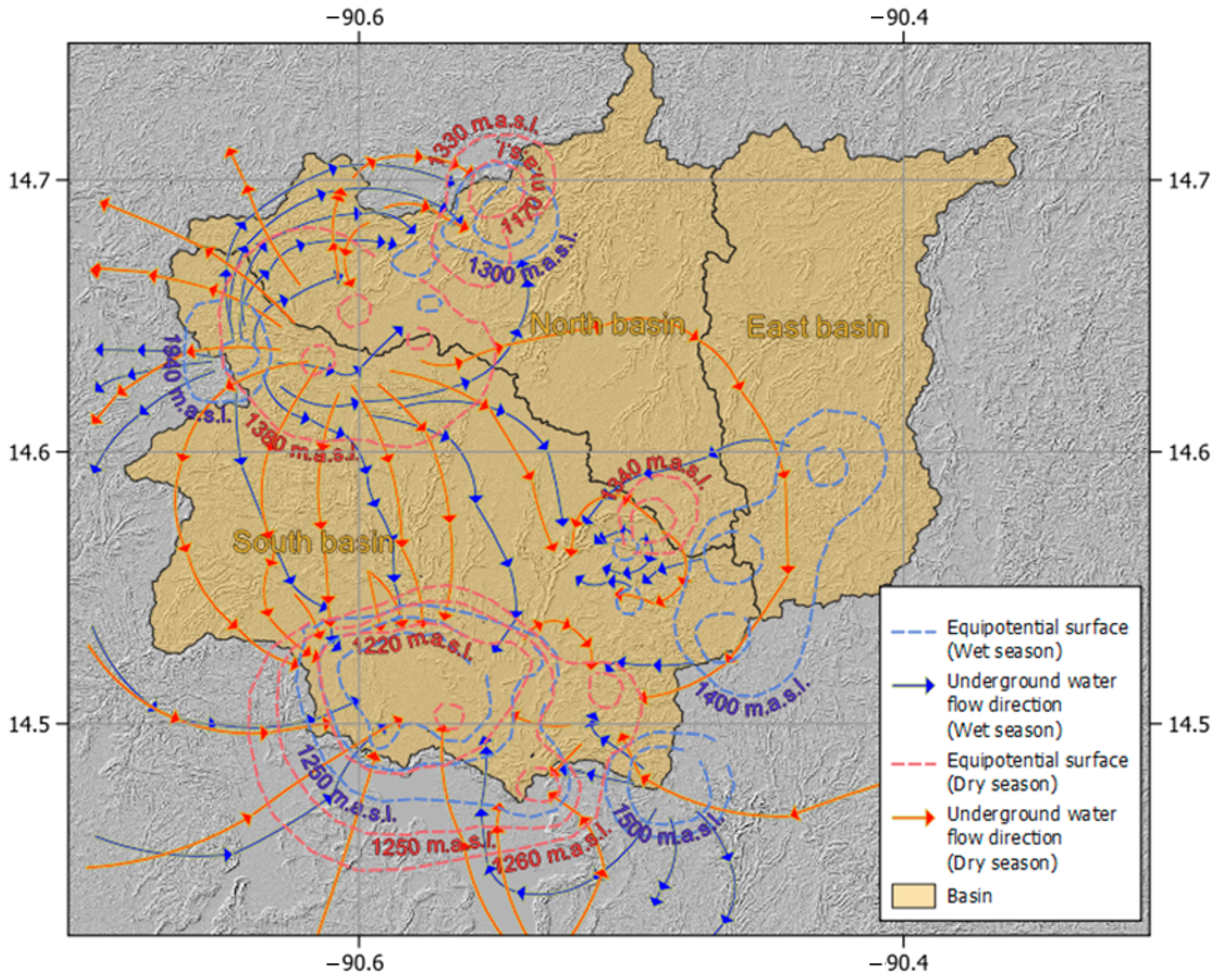
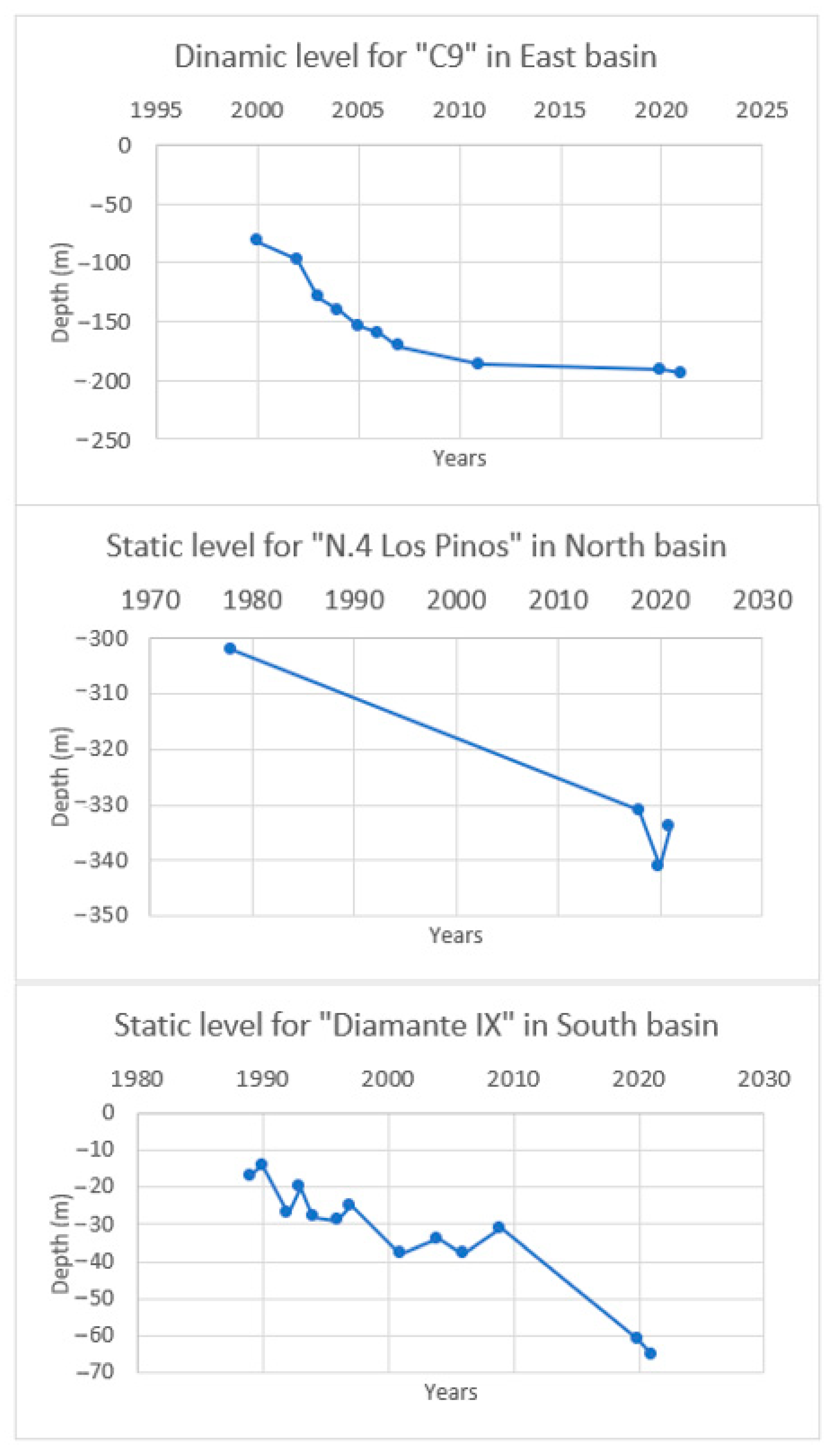
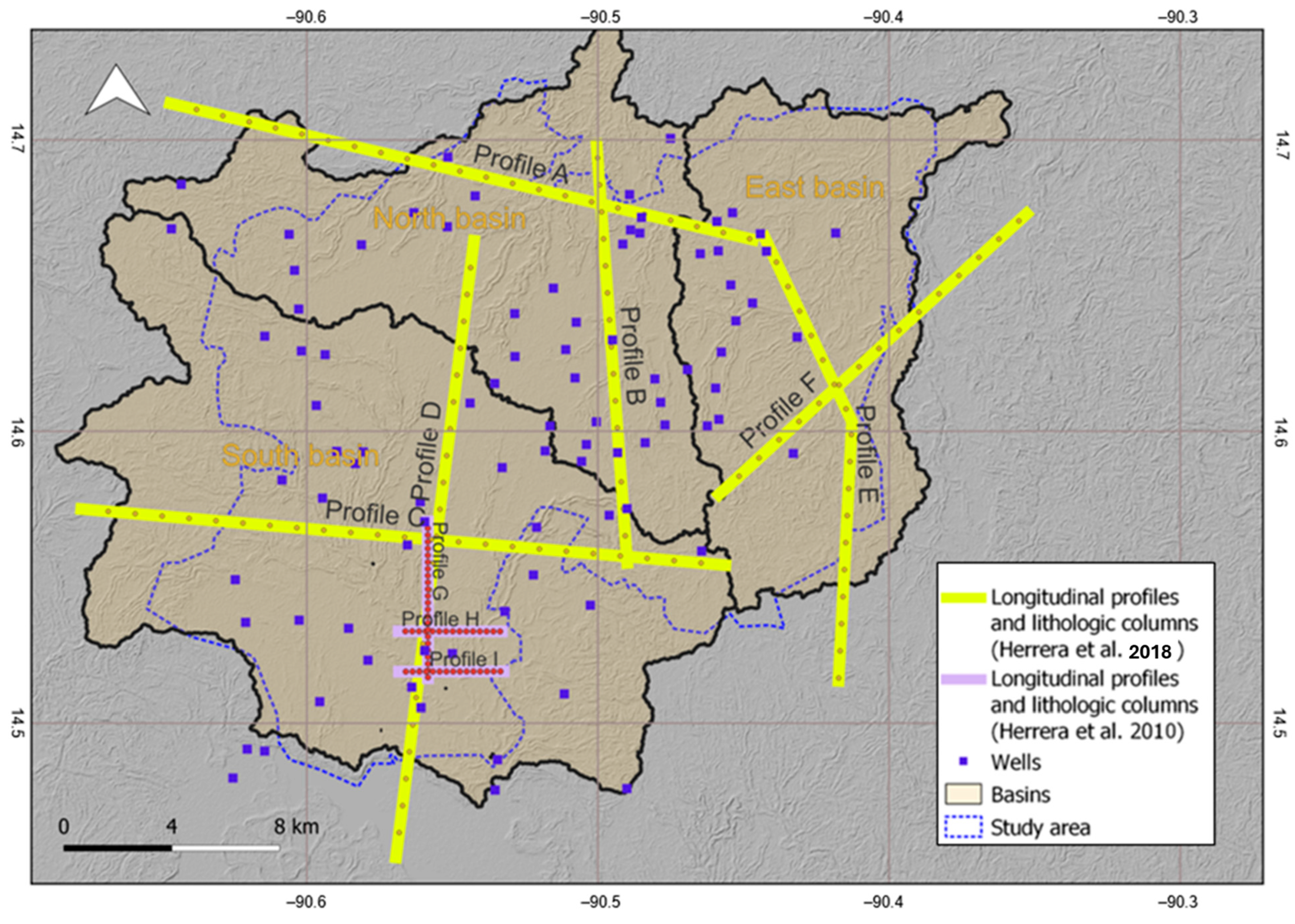
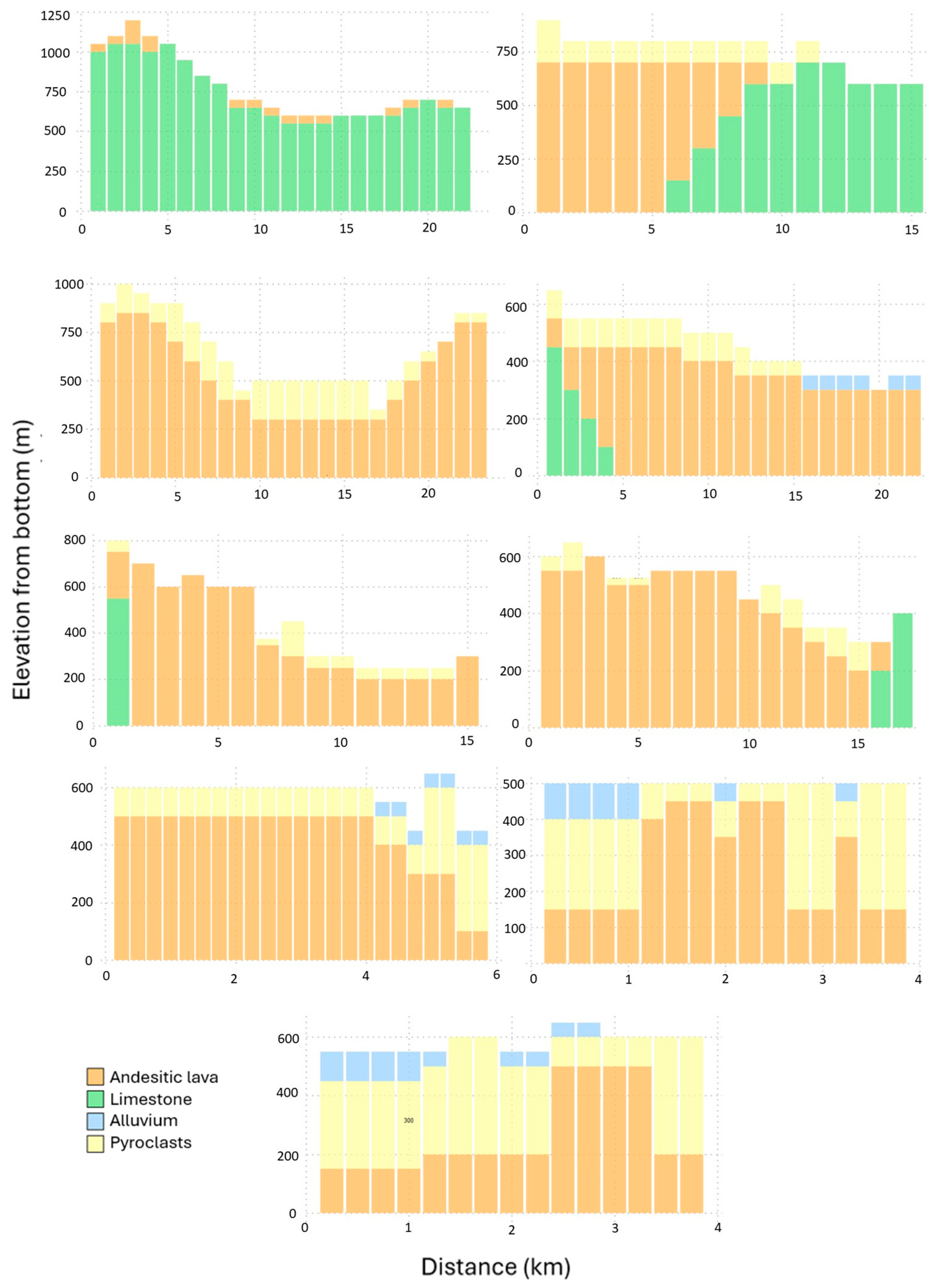



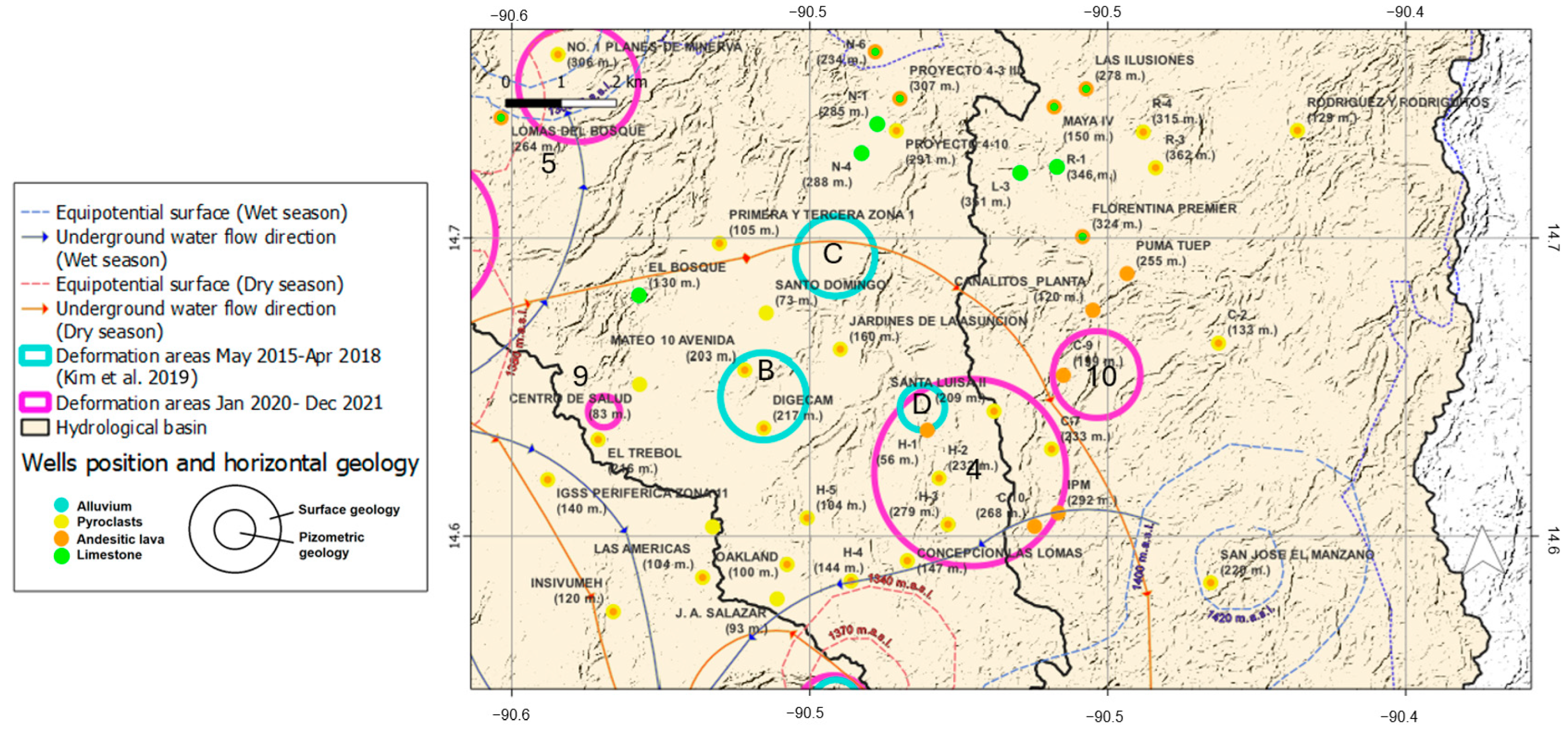

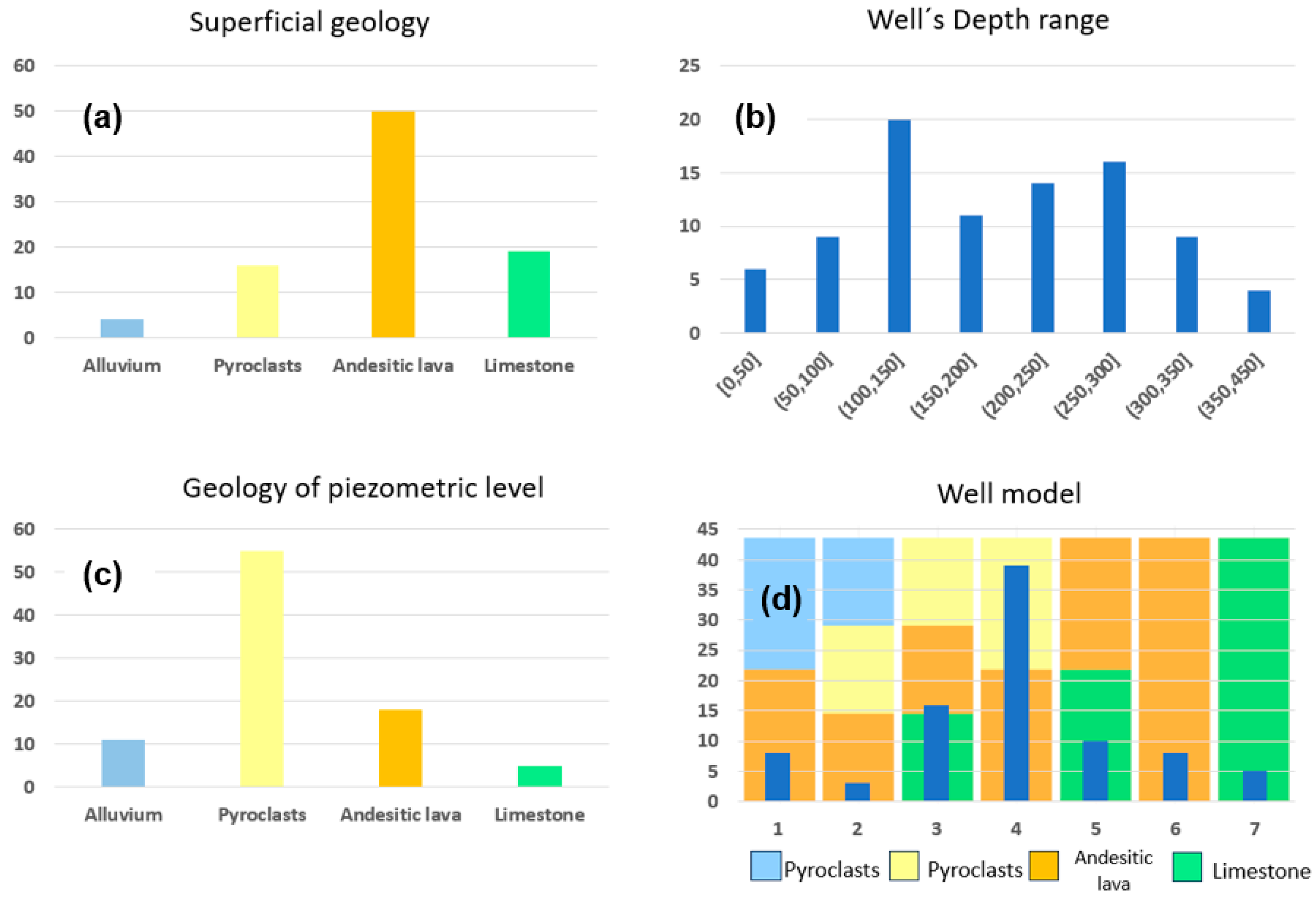

| Satellite | First Image | Last Image | Geometry | Orbit | Images | Polarization | Mean Inc. Angle | Heading Angle |
|---|---|---|---|---|---|---|---|---|
| S1A&B | 11 January 2020 | 13 December 2021 | Asc | 136 | 107 | VV | 39.2 | 349.3 |
| S1A&B | 9 January 2020 | 17 December 2021 | Desc | 26 | 111 | VV | 36.5 | 190.6 |
| Slope (°) | ||
|---|---|---|
| Type | Range | Group |
| Flat-swiftly sloped | [0–3.9) | 1 |
| Sloped | [4–6.9) | 2 |
| Moderately sloped | [7–7.9) | 3 |
| Steeped | [8–16.9) | 4 |
| Strongly steeped | [17–30) | 5 |
| AOI | 1 | 2 | 3 * | 4 | 5 | 6 * | 7 * | 8 | 9 | 10 |
|---|---|---|---|---|---|---|---|---|---|---|
| Basin | North | North | North | North-East | North | South | East-South | South | North | East |
| Location | W Mixco | Zone 19 | E Mixco | Zones 16-17-24 | Mixco | Villa Nueva-Petapa | Santa Catarina de Pinula | Santa Catarina de Pinula, Zones 10-14-15 | Zones 3-7 | Zone 24 |
| Average | −9.1 | −10.0 | −10.4 | −10.9 | −7.0 | −8.9 | −8.0 | −6.1 | −7.6 | −11.6 |
| Maximum | −31 | −28.6 | −30.7 | −52.9 | −20.4 | −62.0 | −23.2 | −22.2 | −29.4 | −21.5 |
| Area | A | B | C | D |
|---|---|---|---|---|
| Basin | South | North | North | North |
| Location | Santa Catarina de Pinula, Zones 10-14-15 | Zone 5 | Zones 1-5-6 | Zone 16 |
| Average | −7.3 | −4.5 | −4.0 | −9.5 |
| Maximum | −22.2 | −23.0 | −17.8 | −20.2 |
Disclaimer/Publisher’s Note: The statements, opinions and data contained in all publications are solely those of the individual author(s) and contributor(s) and not of MDPI and/or the editor(s). MDPI and/or the editor(s) disclaim responsibility for any injury to people or property resulting from any ideas, methods, instructions or products referred to in the content. |
© 2025 by the authors. Licensee MDPI, Basel, Switzerland. This article is an open access article distributed under the terms and conditions of the Creative Commons Attribution (CC BY) license (https://creativecommons.org/licenses/by/4.0/).
Share and Cite
García-Lanchares, C.; Fernández-Landa, A.; Armayor, J.L.; Hernández-Rubio, O.; Marchamalo-Sacristán, M. The Influence of Groundwater Management on Land Subsidence Patterns in the Metropolitan Region of Guatemala City: A Multi-Temporal InSAR Analysis. Remote Sens. 2025, 17, 1496. https://doi.org/10.3390/rs17091496
García-Lanchares C, Fernández-Landa A, Armayor JL, Hernández-Rubio O, Marchamalo-Sacristán M. The Influence of Groundwater Management on Land Subsidence Patterns in the Metropolitan Region of Guatemala City: A Multi-Temporal InSAR Analysis. Remote Sensing. 2025; 17(9):1496. https://doi.org/10.3390/rs17091496
Chicago/Turabian StyleGarcía-Lanchares, Carlos, Alfredo Fernández-Landa, José Luis Armayor, Orlando Hernández-Rubio, and Miguel Marchamalo-Sacristán. 2025. "The Influence of Groundwater Management on Land Subsidence Patterns in the Metropolitan Region of Guatemala City: A Multi-Temporal InSAR Analysis" Remote Sensing 17, no. 9: 1496. https://doi.org/10.3390/rs17091496
APA StyleGarcía-Lanchares, C., Fernández-Landa, A., Armayor, J. L., Hernández-Rubio, O., & Marchamalo-Sacristán, M. (2025). The Influence of Groundwater Management on Land Subsidence Patterns in the Metropolitan Region of Guatemala City: A Multi-Temporal InSAR Analysis. Remote Sensing, 17(9), 1496. https://doi.org/10.3390/rs17091496








